An Analysis of the Association Between Illness and Stress
VerifiedAdded on 2022/08/24
|12
|3590
|29
Essay
AI Summary
This essay delves into the intricate relationship between stress and illness, examining how psychological pressure and strain influence the body's homeostasis. It explores the physiological responses to stressors, including the release of stress hormones like cortisol, and their impact on the cardiovascular, endocrine, nervous, and immune systems. The essay discusses how prolonged stress can contribute to conditions such as diabetes, hypertension, and cardiovascular abnormalities, as well as impact mental health. It also addresses factors like coping mechanisms, genetic vulnerability, and social support in relation to stress and illness. The essay further examines the effects of stress on the immune system, respiratory health, and the progression of conditions like HIV and schizophrenia. The conclusion emphasizes the importance of understanding stress as a fundamental factor in health and well-being, and the need for adaptive responses to maintain a balanced internal environment.
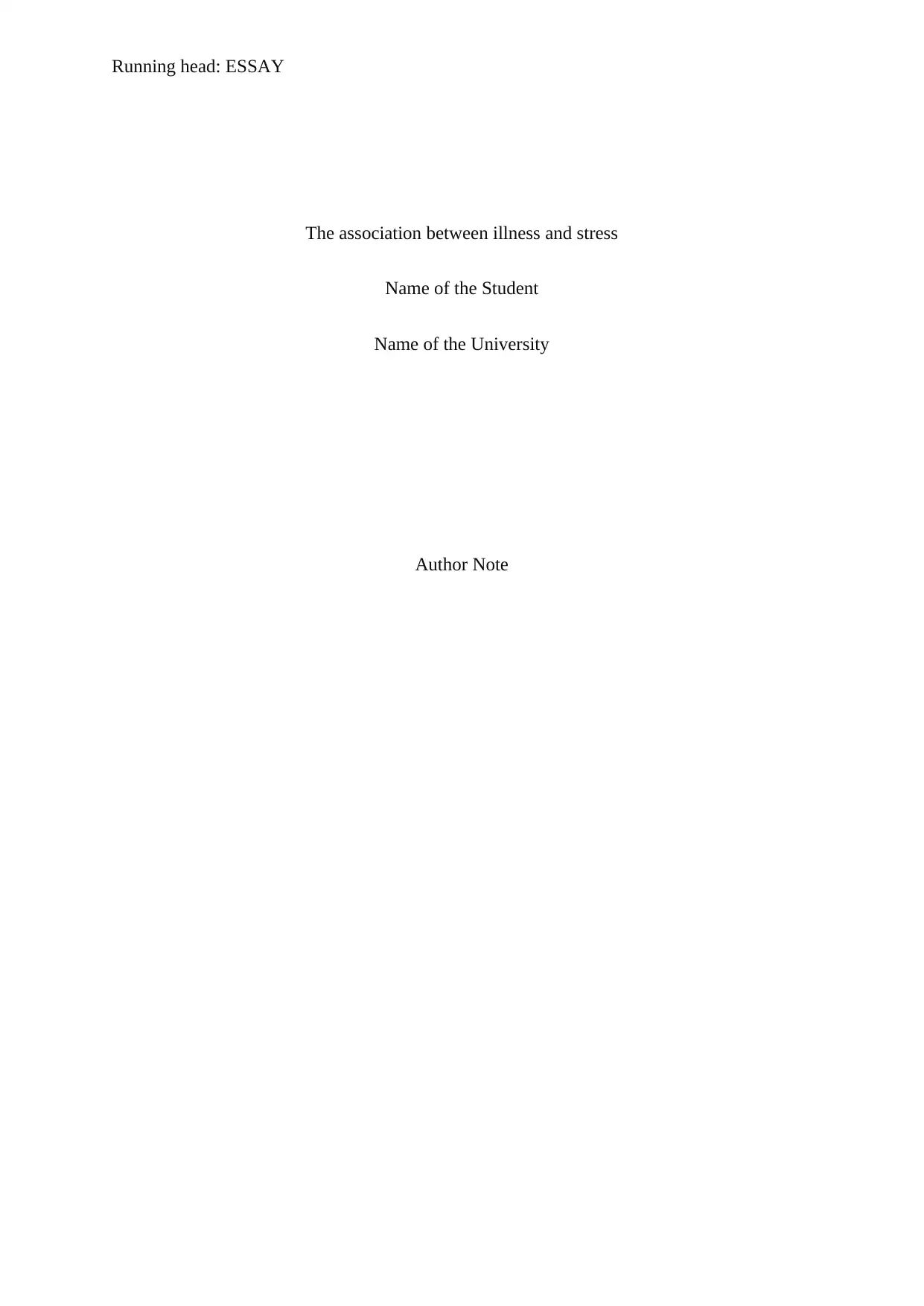
Running head: ESSAY
The association between illness and stress
Name of the Student
Name of the University
Author Note
The association between illness and stress
Name of the Student
Name of the University
Author Note
Paraphrase This Document
Need a fresh take? Get an instant paraphrase of this document with our AI Paraphraser
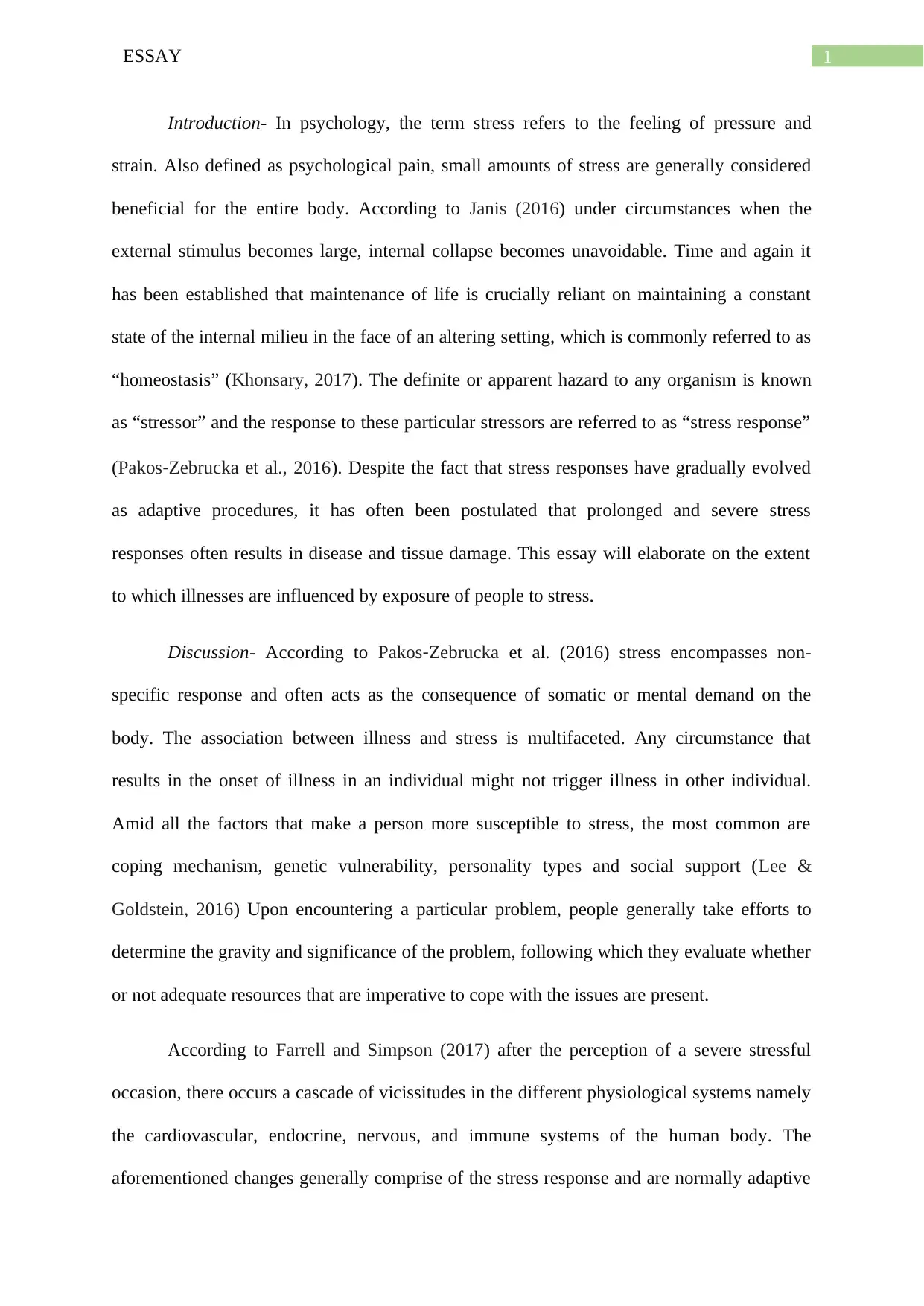
1ESSAY
Introduction- In psychology, the term stress refers to the feeling of pressure and
strain. Also defined as psychological pain, small amounts of stress are generally considered
beneficial for the entire body. According to Janis (2016) under circumstances when the
external stimulus becomes large, internal collapse becomes unavoidable. Time and again it
has been established that maintenance of life is crucially reliant on maintaining a constant
state of the internal milieu in the face of an altering setting, which is commonly referred to as
“homeostasis” (Khonsary, 2017). The definite or apparent hazard to any organism is known
as “stressor” and the response to these particular stressors are referred to as “stress response”
(Pakos‐Zebrucka et al., 2016). Despite the fact that stress responses have gradually evolved
as adaptive procedures, it has often been postulated that prolonged and severe stress
responses often results in disease and tissue damage. This essay will elaborate on the extent
to which illnesses are influenced by exposure of people to stress.
Discussion- According to Pakos‐Zebrucka et al. (2016) stress encompasses non-
specific response and often acts as the consequence of somatic or mental demand on the
body. The association between illness and stress is multifaceted. Any circumstance that
results in the onset of illness in an individual might not trigger illness in other individual.
Amid all the factors that make a person more susceptible to stress, the most common are
coping mechanism, genetic vulnerability, personality types and social support (Lee &
Goldstein, 2016) Upon encountering a particular problem, people generally take efforts to
determine the gravity and significance of the problem, following which they evaluate whether
or not adequate resources that are imperative to cope with the issues are present.
According to Farrell and Simpson (2017) after the perception of a severe stressful
occasion, there occurs a cascade of vicissitudes in the different physiological systems namely
the cardiovascular, endocrine, nervous, and immune systems of the human body. The
aforementioned changes generally comprise of the stress response and are normally adaptive
Introduction- In psychology, the term stress refers to the feeling of pressure and
strain. Also defined as psychological pain, small amounts of stress are generally considered
beneficial for the entire body. According to Janis (2016) under circumstances when the
external stimulus becomes large, internal collapse becomes unavoidable. Time and again it
has been established that maintenance of life is crucially reliant on maintaining a constant
state of the internal milieu in the face of an altering setting, which is commonly referred to as
“homeostasis” (Khonsary, 2017). The definite or apparent hazard to any organism is known
as “stressor” and the response to these particular stressors are referred to as “stress response”
(Pakos‐Zebrucka et al., 2016). Despite the fact that stress responses have gradually evolved
as adaptive procedures, it has often been postulated that prolonged and severe stress
responses often results in disease and tissue damage. This essay will elaborate on the extent
to which illnesses are influenced by exposure of people to stress.
Discussion- According to Pakos‐Zebrucka et al. (2016) stress encompasses non-
specific response and often acts as the consequence of somatic or mental demand on the
body. The association between illness and stress is multifaceted. Any circumstance that
results in the onset of illness in an individual might not trigger illness in other individual.
Amid all the factors that make a person more susceptible to stress, the most common are
coping mechanism, genetic vulnerability, personality types and social support (Lee &
Goldstein, 2016) Upon encountering a particular problem, people generally take efforts to
determine the gravity and significance of the problem, following which they evaluate whether
or not adequate resources that are imperative to cope with the issues are present.
According to Farrell and Simpson (2017) after the perception of a severe stressful
occasion, there occurs a cascade of vicissitudes in the different physiological systems namely
the cardiovascular, endocrine, nervous, and immune systems of the human body. The
aforementioned changes generally comprise of the stress response and are normally adaptive
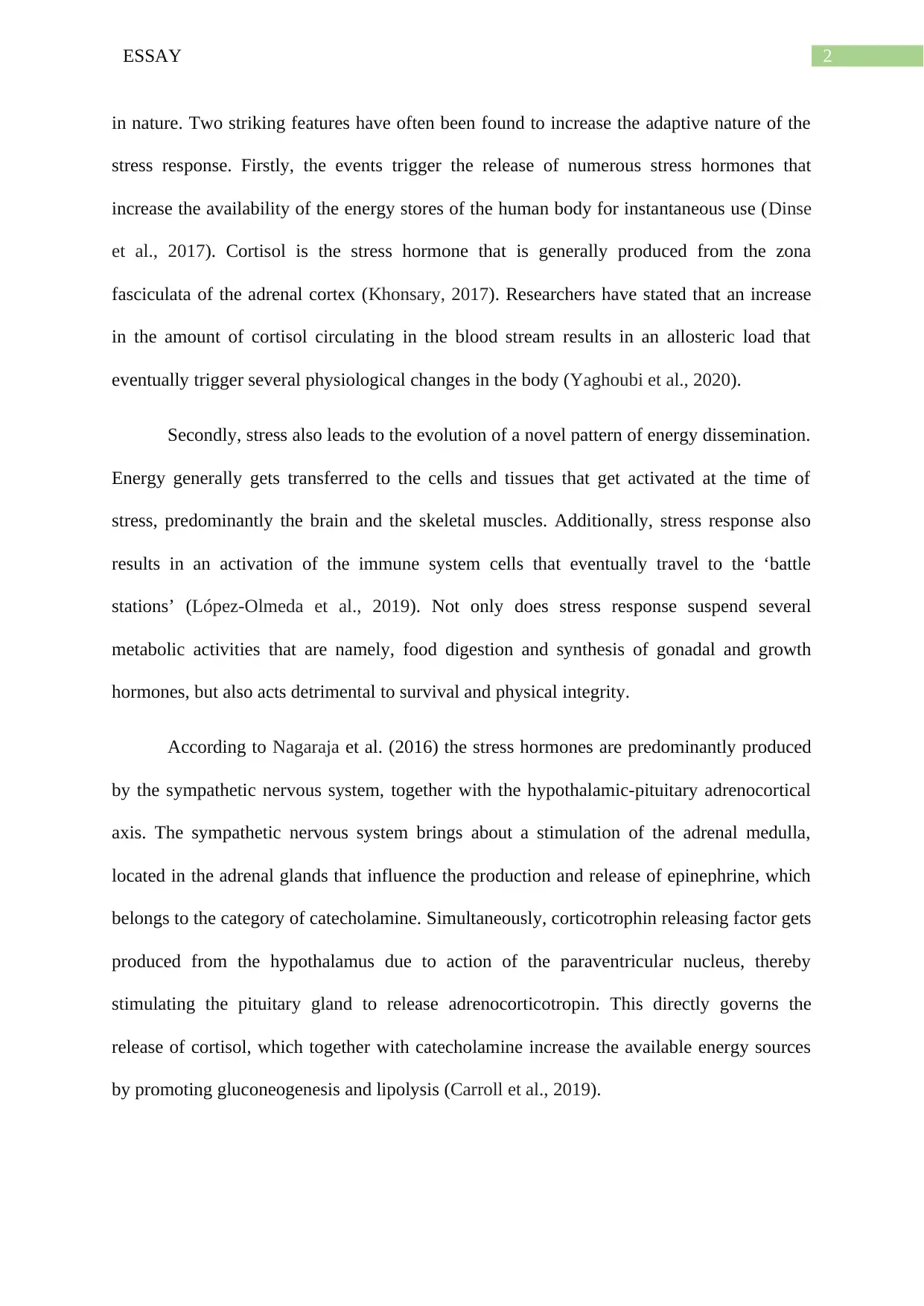
2ESSAY
in nature. Two striking features have often been found to increase the adaptive nature of the
stress response. Firstly, the events trigger the release of numerous stress hormones that
increase the availability of the energy stores of the human body for instantaneous use (Dinse
et al., 2017). Cortisol is the stress hormone that is generally produced from the zona
fasciculata of the adrenal cortex (Khonsary, 2017). Researchers have stated that an increase
in the amount of cortisol circulating in the blood stream results in an allosteric load that
eventually trigger several physiological changes in the body (Yaghoubi et al., 2020).
Secondly, stress also leads to the evolution of a novel pattern of energy dissemination.
Energy generally gets transferred to the cells and tissues that get activated at the time of
stress, predominantly the brain and the skeletal muscles. Additionally, stress response also
results in an activation of the immune system cells that eventually travel to the ‘battle
stations’ (López-Olmeda et al., 2019). Not only does stress response suspend several
metabolic activities that are namely, food digestion and synthesis of gonadal and growth
hormones, but also acts detrimental to survival and physical integrity.
According to Nagaraja et al. (2016) the stress hormones are predominantly produced
by the sympathetic nervous system, together with the hypothalamic-pituitary adrenocortical
axis. The sympathetic nervous system brings about a stimulation of the adrenal medulla,
located in the adrenal glands that influence the production and release of epinephrine, which
belongs to the category of catecholamine. Simultaneously, corticotrophin releasing factor gets
produced from the hypothalamus due to action of the paraventricular nucleus, thereby
stimulating the pituitary gland to release adrenocorticotropin. This directly governs the
release of cortisol, which together with catecholamine increase the available energy sources
by promoting gluconeogenesis and lipolysis (Carroll et al., 2019).
in nature. Two striking features have often been found to increase the adaptive nature of the
stress response. Firstly, the events trigger the release of numerous stress hormones that
increase the availability of the energy stores of the human body for instantaneous use (Dinse
et al., 2017). Cortisol is the stress hormone that is generally produced from the zona
fasciculata of the adrenal cortex (Khonsary, 2017). Researchers have stated that an increase
in the amount of cortisol circulating in the blood stream results in an allosteric load that
eventually trigger several physiological changes in the body (Yaghoubi et al., 2020).
Secondly, stress also leads to the evolution of a novel pattern of energy dissemination.
Energy generally gets transferred to the cells and tissues that get activated at the time of
stress, predominantly the brain and the skeletal muscles. Additionally, stress response also
results in an activation of the immune system cells that eventually travel to the ‘battle
stations’ (López-Olmeda et al., 2019). Not only does stress response suspend several
metabolic activities that are namely, food digestion and synthesis of gonadal and growth
hormones, but also acts detrimental to survival and physical integrity.
According to Nagaraja et al. (2016) the stress hormones are predominantly produced
by the sympathetic nervous system, together with the hypothalamic-pituitary adrenocortical
axis. The sympathetic nervous system brings about a stimulation of the adrenal medulla,
located in the adrenal glands that influence the production and release of epinephrine, which
belongs to the category of catecholamine. Simultaneously, corticotrophin releasing factor gets
produced from the hypothalamus due to action of the paraventricular nucleus, thereby
stimulating the pituitary gland to release adrenocorticotropin. This directly governs the
release of cortisol, which together with catecholamine increase the available energy sources
by promoting gluconeogenesis and lipolysis (Carroll et al., 2019).
⊘ This is a preview!⊘
Do you want full access?
Subscribe today to unlock all pages.

Trusted by 1+ million students worldwide
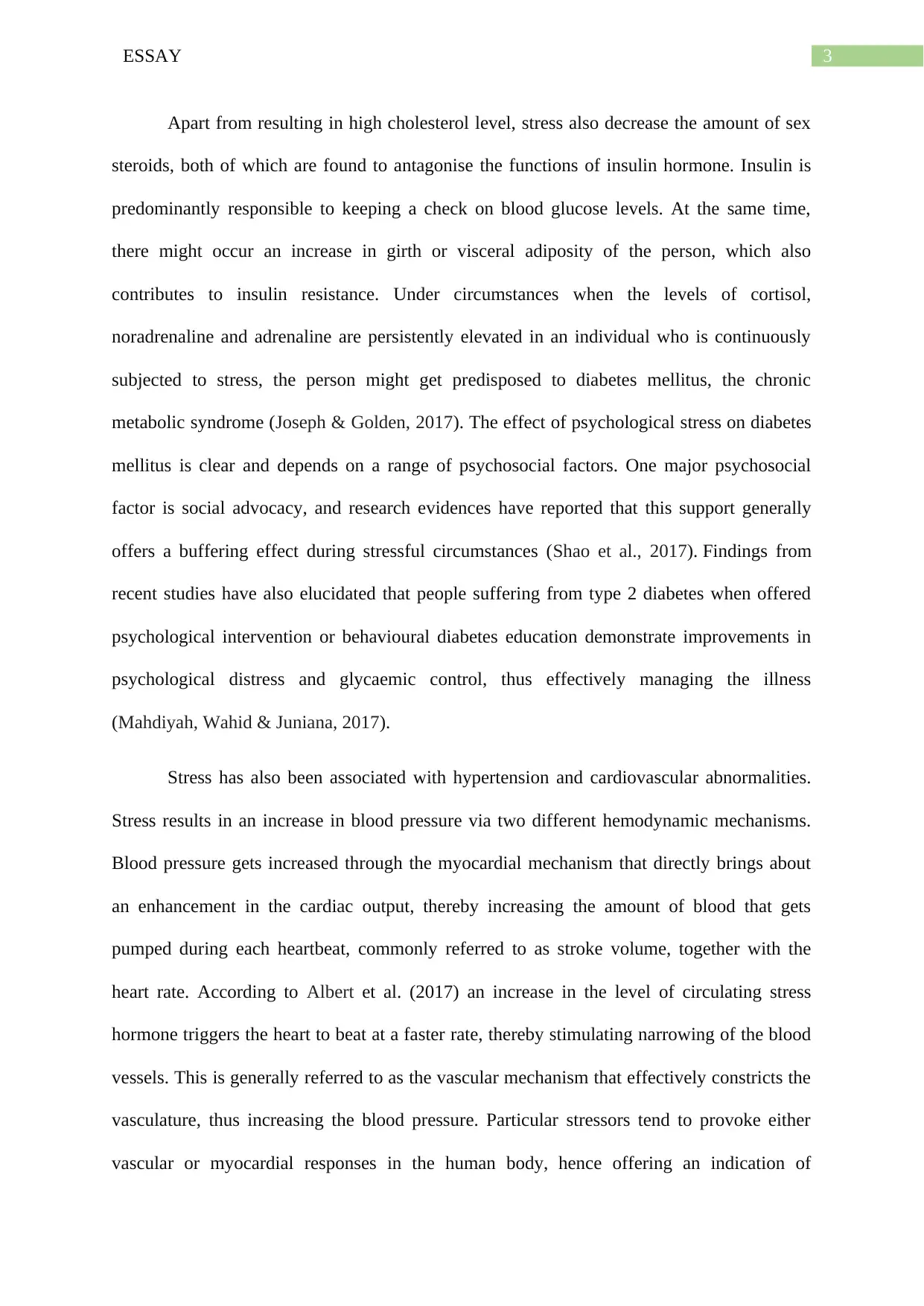
3ESSAY
Apart from resulting in high cholesterol level, stress also decrease the amount of sex
steroids, both of which are found to antagonise the functions of insulin hormone. Insulin is
predominantly responsible to keeping a check on blood glucose levels. At the same time,
there might occur an increase in girth or visceral adiposity of the person, which also
contributes to insulin resistance. Under circumstances when the levels of cortisol,
noradrenaline and adrenaline are persistently elevated in an individual who is continuously
subjected to stress, the person might get predisposed to diabetes mellitus, the chronic
metabolic syndrome (Joseph & Golden, 2017). The effect of psychological stress on diabetes
mellitus is clear and depends on a range of psychosocial factors. One major psychosocial
factor is social advocacy, and research evidences have reported that this support generally
offers a buffering effect during stressful circumstances (Shao et al., 2017). Findings from
recent studies have also elucidated that people suffering from type 2 diabetes when offered
psychological intervention or behavioural diabetes education demonstrate improvements in
psychological distress and glycaemic control, thus effectively managing the illness
(Mahdiyah, Wahid & Juniana, 2017).
Stress has also been associated with hypertension and cardiovascular abnormalities.
Stress results in an increase in blood pressure via two different hemodynamic mechanisms.
Blood pressure gets increased through the myocardial mechanism that directly brings about
an enhancement in the cardiac output, thereby increasing the amount of blood that gets
pumped during each heartbeat, commonly referred to as stroke volume, together with the
heart rate. According to Albert et al. (2017) an increase in the level of circulating stress
hormone triggers the heart to beat at a faster rate, thereby stimulating narrowing of the blood
vessels. This is generally referred to as the vascular mechanism that effectively constricts the
vasculature, thus increasing the blood pressure. Particular stressors tend to provoke either
vascular or myocardial responses in the human body, hence offering an indication of
Apart from resulting in high cholesterol level, stress also decrease the amount of sex
steroids, both of which are found to antagonise the functions of insulin hormone. Insulin is
predominantly responsible to keeping a check on blood glucose levels. At the same time,
there might occur an increase in girth or visceral adiposity of the person, which also
contributes to insulin resistance. Under circumstances when the levels of cortisol,
noradrenaline and adrenaline are persistently elevated in an individual who is continuously
subjected to stress, the person might get predisposed to diabetes mellitus, the chronic
metabolic syndrome (Joseph & Golden, 2017). The effect of psychological stress on diabetes
mellitus is clear and depends on a range of psychosocial factors. One major psychosocial
factor is social advocacy, and research evidences have reported that this support generally
offers a buffering effect during stressful circumstances (Shao et al., 2017). Findings from
recent studies have also elucidated that people suffering from type 2 diabetes when offered
psychological intervention or behavioural diabetes education demonstrate improvements in
psychological distress and glycaemic control, thus effectively managing the illness
(Mahdiyah, Wahid & Juniana, 2017).
Stress has also been associated with hypertension and cardiovascular abnormalities.
Stress results in an increase in blood pressure via two different hemodynamic mechanisms.
Blood pressure gets increased through the myocardial mechanism that directly brings about
an enhancement in the cardiac output, thereby increasing the amount of blood that gets
pumped during each heartbeat, commonly referred to as stroke volume, together with the
heart rate. According to Albert et al. (2017) an increase in the level of circulating stress
hormone triggers the heart to beat at a faster rate, thereby stimulating narrowing of the blood
vessels. This is generally referred to as the vascular mechanism that effectively constricts the
vasculature, thus increasing the blood pressure. Particular stressors tend to provoke either
vascular or myocardial responses in the human body, hence offering an indication of
Paraphrase This Document
Need a fresh take? Get an instant paraphrase of this document with our AI Paraphraser
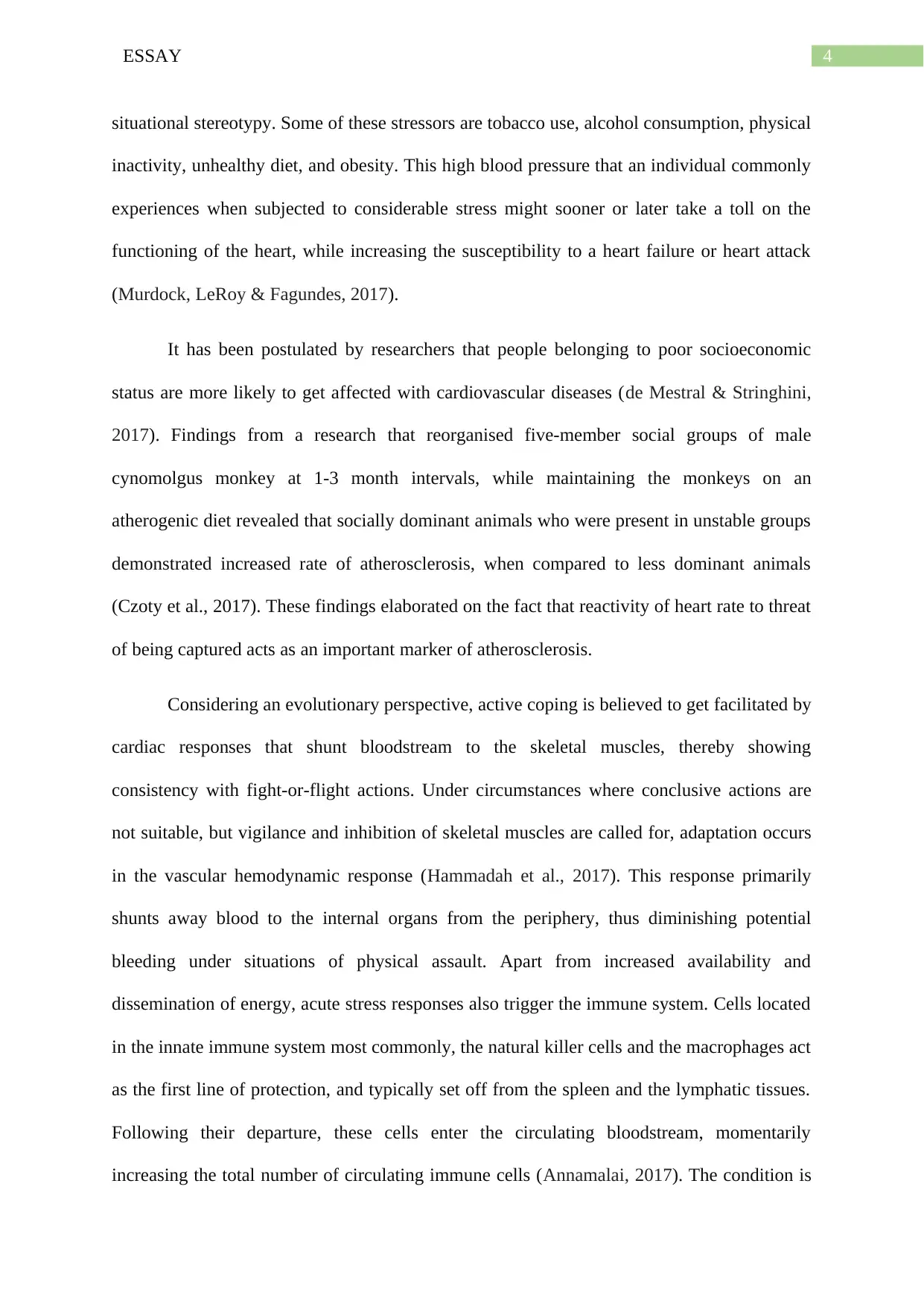
4ESSAY
situational stereotypy. Some of these stressors are tobacco use, alcohol consumption, physical
inactivity, unhealthy diet, and obesity. This high blood pressure that an individual commonly
experiences when subjected to considerable stress might sooner or later take a toll on the
functioning of the heart, while increasing the susceptibility to a heart failure or heart attack
(Murdock, LeRoy & Fagundes, 2017).
It has been postulated by researchers that people belonging to poor socioeconomic
status are more likely to get affected with cardiovascular diseases (de Mestral & Stringhini,
2017). Findings from a research that reorganised five-member social groups of male
cynomolgus monkey at 1-3 month intervals, while maintaining the monkeys on an
atherogenic diet revealed that socially dominant animals who were present in unstable groups
demonstrated increased rate of atherosclerosis, when compared to less dominant animals
(Czoty et al., 2017). These findings elaborated on the fact that reactivity of heart rate to threat
of being captured acts as an important marker of atherosclerosis.
Considering an evolutionary perspective, active coping is believed to get facilitated by
cardiac responses that shunt bloodstream to the skeletal muscles, thereby showing
consistency with fight-or-flight actions. Under circumstances where conclusive actions are
not suitable, but vigilance and inhibition of skeletal muscles are called for, adaptation occurs
in the vascular hemodynamic response (Hammadah et al., 2017). This response primarily
shunts away blood to the internal organs from the periphery, thus diminishing potential
bleeding under situations of physical assault. Apart from increased availability and
dissemination of energy, acute stress responses also trigger the immune system. Cells located
in the innate immune system most commonly, the natural killer cells and the macrophages act
as the first line of protection, and typically set off from the spleen and the lymphatic tissues.
Following their departure, these cells enter the circulating bloodstream, momentarily
increasing the total number of circulating immune cells (Annamalai, 2017). The condition is
situational stereotypy. Some of these stressors are tobacco use, alcohol consumption, physical
inactivity, unhealthy diet, and obesity. This high blood pressure that an individual commonly
experiences when subjected to considerable stress might sooner or later take a toll on the
functioning of the heart, while increasing the susceptibility to a heart failure or heart attack
(Murdock, LeRoy & Fagundes, 2017).
It has been postulated by researchers that people belonging to poor socioeconomic
status are more likely to get affected with cardiovascular diseases (de Mestral & Stringhini,
2017). Findings from a research that reorganised five-member social groups of male
cynomolgus monkey at 1-3 month intervals, while maintaining the monkeys on an
atherogenic diet revealed that socially dominant animals who were present in unstable groups
demonstrated increased rate of atherosclerosis, when compared to less dominant animals
(Czoty et al., 2017). These findings elaborated on the fact that reactivity of heart rate to threat
of being captured acts as an important marker of atherosclerosis.
Considering an evolutionary perspective, active coping is believed to get facilitated by
cardiac responses that shunt bloodstream to the skeletal muscles, thereby showing
consistency with fight-or-flight actions. Under circumstances where conclusive actions are
not suitable, but vigilance and inhibition of skeletal muscles are called for, adaptation occurs
in the vascular hemodynamic response (Hammadah et al., 2017). This response primarily
shunts away blood to the internal organs from the periphery, thus diminishing potential
bleeding under situations of physical assault. Apart from increased availability and
dissemination of energy, acute stress responses also trigger the immune system. Cells located
in the innate immune system most commonly, the natural killer cells and the macrophages act
as the first line of protection, and typically set off from the spleen and the lymphatic tissues.
Following their departure, these cells enter the circulating bloodstream, momentarily
increasing the total number of circulating immune cells (Annamalai, 2017). The condition is
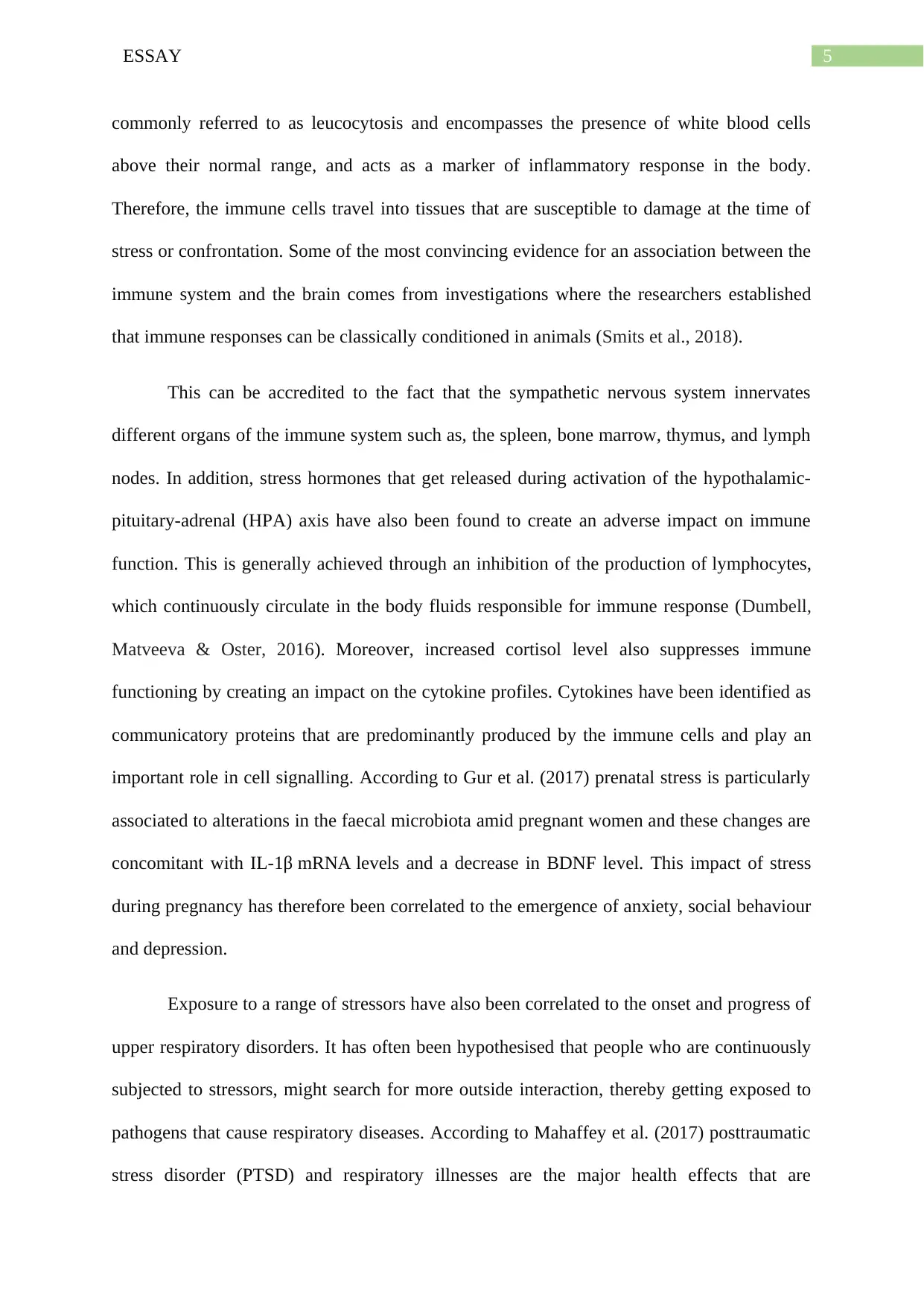
5ESSAY
commonly referred to as leucocytosis and encompasses the presence of white blood cells
above their normal range, and acts as a marker of inflammatory response in the body.
Therefore, the immune cells travel into tissues that are susceptible to damage at the time of
stress or confrontation. Some of the most convincing evidence for an association between the
immune system and the brain comes from investigations where the researchers established
that immune responses can be classically conditioned in animals (Smits et al., 2018).
This can be accredited to the fact that the sympathetic nervous system innervates
different organs of the immune system such as, the spleen, bone marrow, thymus, and lymph
nodes. In addition, stress hormones that get released during activation of the hypothalamic-
pituitary-adrenal (HPA) axis have also been found to create an adverse impact on immune
function. This is generally achieved through an inhibition of the production of lymphocytes,
which continuously circulate in the body fluids responsible for immune response (Dumbell,
Matveeva & Oster, 2016). Moreover, increased cortisol level also suppresses immune
functioning by creating an impact on the cytokine profiles. Cytokines have been identified as
communicatory proteins that are predominantly produced by the immune cells and play an
important role in cell signalling. According to Gur et al. (2017) prenatal stress is particularly
associated to alterations in the faecal microbiota amid pregnant women and these changes are
concomitant with IL-1β mRNA levels and a decrease in BDNF level. This impact of stress
during pregnancy has therefore been correlated to the emergence of anxiety, social behaviour
and depression.
Exposure to a range of stressors have also been correlated to the onset and progress of
upper respiratory disorders. It has often been hypothesised that people who are continuously
subjected to stressors, might search for more outside interaction, thereby getting exposed to
pathogens that cause respiratory diseases. According to Mahaffey et al. (2017) posttraumatic
stress disorder (PTSD) and respiratory illnesses are the major health effects that are
commonly referred to as leucocytosis and encompasses the presence of white blood cells
above their normal range, and acts as a marker of inflammatory response in the body.
Therefore, the immune cells travel into tissues that are susceptible to damage at the time of
stress or confrontation. Some of the most convincing evidence for an association between the
immune system and the brain comes from investigations where the researchers established
that immune responses can be classically conditioned in animals (Smits et al., 2018).
This can be accredited to the fact that the sympathetic nervous system innervates
different organs of the immune system such as, the spleen, bone marrow, thymus, and lymph
nodes. In addition, stress hormones that get released during activation of the hypothalamic-
pituitary-adrenal (HPA) axis have also been found to create an adverse impact on immune
function. This is generally achieved through an inhibition of the production of lymphocytes,
which continuously circulate in the body fluids responsible for immune response (Dumbell,
Matveeva & Oster, 2016). Moreover, increased cortisol level also suppresses immune
functioning by creating an impact on the cytokine profiles. Cytokines have been identified as
communicatory proteins that are predominantly produced by the immune cells and play an
important role in cell signalling. According to Gur et al. (2017) prenatal stress is particularly
associated to alterations in the faecal microbiota amid pregnant women and these changes are
concomitant with IL-1β mRNA levels and a decrease in BDNF level. This impact of stress
during pregnancy has therefore been correlated to the emergence of anxiety, social behaviour
and depression.
Exposure to a range of stressors have also been correlated to the onset and progress of
upper respiratory disorders. It has often been hypothesised that people who are continuously
subjected to stressors, might search for more outside interaction, thereby getting exposed to
pathogens that cause respiratory diseases. According to Mahaffey et al. (2017) posttraumatic
stress disorder (PTSD) and respiratory illnesses are the major health effects that are
⊘ This is a preview!⊘
Do you want full access?
Subscribe today to unlock all pages.

Trusted by 1+ million students worldwide

6ESSAY
concomitant with the World Trade Centre disaster and they recurrently take place. Findings
from their study elucidated that increased intensities of PTSD symptoms displayed a positive
correlation with high levels of LRS. This in turn can be accredited to the fact individuals who
suffer from high anxiety sensitivity have the notion that physiological perturbations provide
an indication for disease, thereby have the likelihood of attending to variations in both
anxious arousal and respiration symptoms, while interpreting them as hazardous.
Life stressors have also been found responsible for increasing HIV risk amid
individuals. Faster progression of people to AIDS have been correlated with usage of denial
as an effective coping mechanism, increased stressful life events, decreased gratification with
social support, and raised serum cortisol. According to Caceres et al. (2016) adolescents who
did not have any history of forced sexual initiation manifest a likelihood to recognise as
stressors, all life circumstances that are associated to social expectations, grief and loss, rather
than those that are correlated to body images and medical care. Furthermore, such people
affected with HIV are more probable to utilise adaptive responses, in place of avoidance
responses, with the aim of coping with stress.
Furthermore, apart from the impacts that prolonged production of proinflammatory
cytokine create on physical health, it also poorly affects mental health amid susceptible
persons. Throughout the course of an illness such as flu, proinflammatory cytokines are
found to send feedback to the central nervous system, thereby resulting in the onset of signs
and symptoms of exhaustion, reduced appetite, malaise, and lethargy, all of which are allied
with depression (Farooq et al., 2017). Moreover, adolescent stress has also been identified as
a significant driving factor for the development of schizophrenia. Impairment in control of
stress owing to lesions in the prelimbic prefontal cortex that predispose persons to stress
hyper-responsivity, or expose them to considerable stressors, thereby triggering cascade of
proceedings that worsen mental health (Quidé et al., 2019).
concomitant with the World Trade Centre disaster and they recurrently take place. Findings
from their study elucidated that increased intensities of PTSD symptoms displayed a positive
correlation with high levels of LRS. This in turn can be accredited to the fact individuals who
suffer from high anxiety sensitivity have the notion that physiological perturbations provide
an indication for disease, thereby have the likelihood of attending to variations in both
anxious arousal and respiration symptoms, while interpreting them as hazardous.
Life stressors have also been found responsible for increasing HIV risk amid
individuals. Faster progression of people to AIDS have been correlated with usage of denial
as an effective coping mechanism, increased stressful life events, decreased gratification with
social support, and raised serum cortisol. According to Caceres et al. (2016) adolescents who
did not have any history of forced sexual initiation manifest a likelihood to recognise as
stressors, all life circumstances that are associated to social expectations, grief and loss, rather
than those that are correlated to body images and medical care. Furthermore, such people
affected with HIV are more probable to utilise adaptive responses, in place of avoidance
responses, with the aim of coping with stress.
Furthermore, apart from the impacts that prolonged production of proinflammatory
cytokine create on physical health, it also poorly affects mental health amid susceptible
persons. Throughout the course of an illness such as flu, proinflammatory cytokines are
found to send feedback to the central nervous system, thereby resulting in the onset of signs
and symptoms of exhaustion, reduced appetite, malaise, and lethargy, all of which are allied
with depression (Farooq et al., 2017). Moreover, adolescent stress has also been identified as
a significant driving factor for the development of schizophrenia. Impairment in control of
stress owing to lesions in the prelimbic prefontal cortex that predispose persons to stress
hyper-responsivity, or expose them to considerable stressors, thereby triggering cascade of
proceedings that worsen mental health (Quidé et al., 2019).
Paraphrase This Document
Need a fresh take? Get an instant paraphrase of this document with our AI Paraphraser
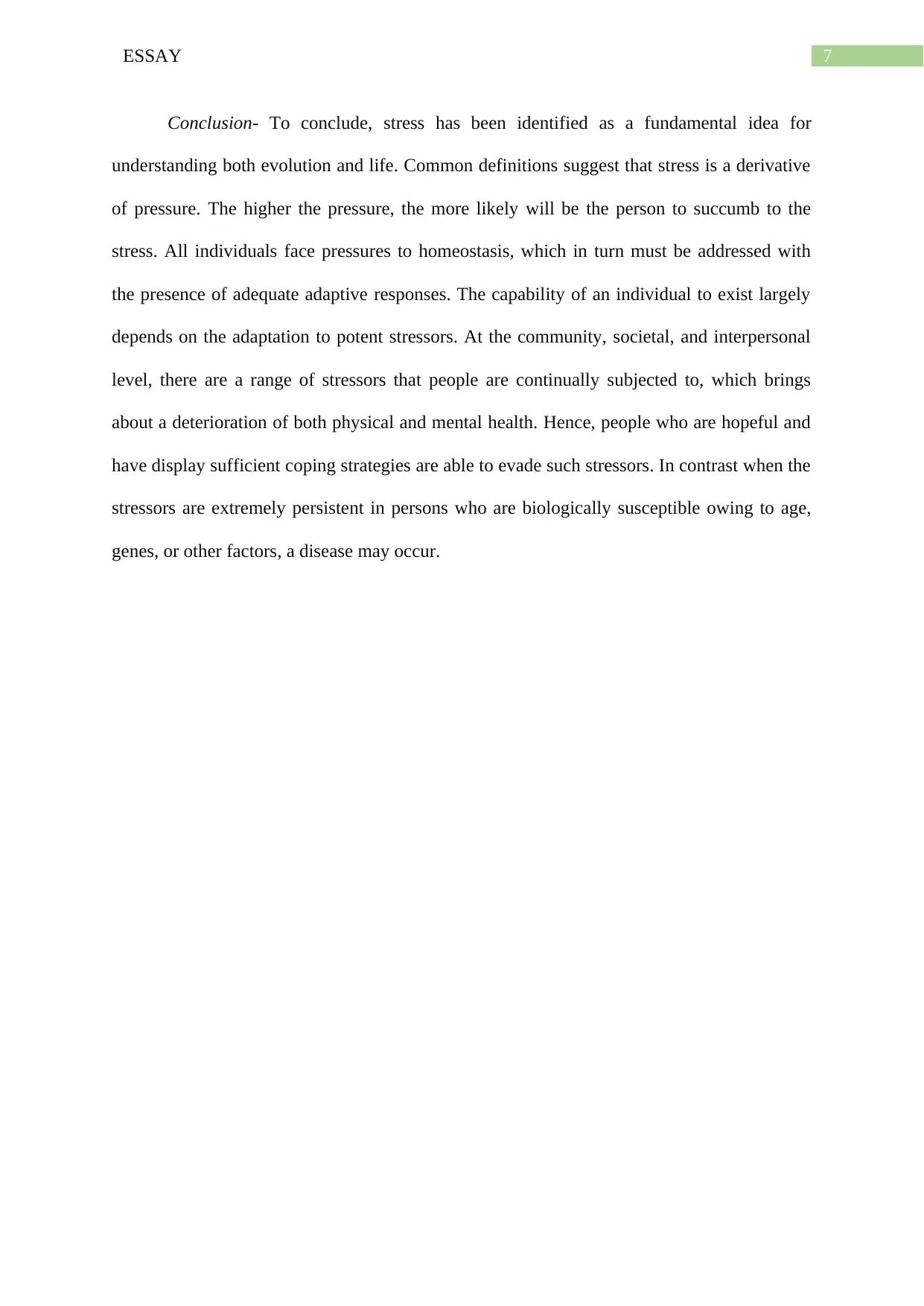
7ESSAY
Conclusion- To conclude, stress has been identified as a fundamental idea for
understanding both evolution and life. Common definitions suggest that stress is a derivative
of pressure. The higher the pressure, the more likely will be the person to succumb to the
stress. All individuals face pressures to homeostasis, which in turn must be addressed with
the presence of adequate adaptive responses. The capability of an individual to exist largely
depends on the adaptation to potent stressors. At the community, societal, and interpersonal
level, there are a range of stressors that people are continually subjected to, which brings
about a deterioration of both physical and mental health. Hence, people who are hopeful and
have display sufficient coping strategies are able to evade such stressors. In contrast when the
stressors are extremely persistent in persons who are biologically susceptible owing to age,
genes, or other factors, a disease may occur.
Conclusion- To conclude, stress has been identified as a fundamental idea for
understanding both evolution and life. Common definitions suggest that stress is a derivative
of pressure. The higher the pressure, the more likely will be the person to succumb to the
stress. All individuals face pressures to homeostasis, which in turn must be addressed with
the presence of adequate adaptive responses. The capability of an individual to exist largely
depends on the adaptation to potent stressors. At the community, societal, and interpersonal
level, there are a range of stressors that people are continually subjected to, which brings
about a deterioration of both physical and mental health. Hence, people who are hopeful and
have display sufficient coping strategies are able to evade such stressors. In contrast when the
stressors are extremely persistent in persons who are biologically susceptible owing to age,
genes, or other factors, a disease may occur.

8ESSAY
References
Albert, M. A., Durazo, E. M., Slopen, N., Zaslavsky, A. M., Buring, J. E., Silva, T., ... &
Williams, D. R. (2017). Cumulative psychological stress and cardiovascular disease
risk in middle aged and older women: Rationale, design, and baseline
characteristics. American heart journal, 192, 1-12.
Annamalai, A. (2017). Leukocytosis. In Medical Management of Psychotropic Side
Effects (pp. 201-203). Springer, Cham.
Caceres, C. F., Stockman, J. K., Brown, B., Ajuwon, A. J., Odetoyinbo, M., Folayan, M. O.,
& Harrison, A. (2016). Associations between Forced Sexual Initiation, HIV Status,
Sexual Risk Behavior, Life Stressors, and Coping Strategies among Adolescents in
Nigeria.
Carroll, B. J., Ritchie, J. C., Rogers, H., & Kim, D. K. (2019). Fast Feedback Inhibition of
Adrenocorticotropic Hormone Secretion by Endogenous Cortisol in
Humans. Neuroendocrinology, 109(4), 299-309.
Czoty, P. W., Gould, R. W., Gage, H. D., & Nader, M. A. (2017). Effects of social
reorganization on dopamine D2/D3 receptor availability and cocaine self-
administration in male cynomolgus monkeys. Psychopharmacology, 234(18), 2673-
2682.
de Mestral, C., & Stringhini, S. (2017). Socioeconomic status and cardiovascular disease: an
update. Current cardiology reports, 19(11), 115.
Dinse, H. R., Kattenstroth, J. C., Lenz, M., Tegenthoff, M., & Wolf, O. T. (2017). The stress
hormone cortisol blocks perceptual learning in
humans. Psychoneuroendocrinology, 77, 63-67.
References
Albert, M. A., Durazo, E. M., Slopen, N., Zaslavsky, A. M., Buring, J. E., Silva, T., ... &
Williams, D. R. (2017). Cumulative psychological stress and cardiovascular disease
risk in middle aged and older women: Rationale, design, and baseline
characteristics. American heart journal, 192, 1-12.
Annamalai, A. (2017). Leukocytosis. In Medical Management of Psychotropic Side
Effects (pp. 201-203). Springer, Cham.
Caceres, C. F., Stockman, J. K., Brown, B., Ajuwon, A. J., Odetoyinbo, M., Folayan, M. O.,
& Harrison, A. (2016). Associations between Forced Sexual Initiation, HIV Status,
Sexual Risk Behavior, Life Stressors, and Coping Strategies among Adolescents in
Nigeria.
Carroll, B. J., Ritchie, J. C., Rogers, H., & Kim, D. K. (2019). Fast Feedback Inhibition of
Adrenocorticotropic Hormone Secretion by Endogenous Cortisol in
Humans. Neuroendocrinology, 109(4), 299-309.
Czoty, P. W., Gould, R. W., Gage, H. D., & Nader, M. A. (2017). Effects of social
reorganization on dopamine D2/D3 receptor availability and cocaine self-
administration in male cynomolgus monkeys. Psychopharmacology, 234(18), 2673-
2682.
de Mestral, C., & Stringhini, S. (2017). Socioeconomic status and cardiovascular disease: an
update. Current cardiology reports, 19(11), 115.
Dinse, H. R., Kattenstroth, J. C., Lenz, M., Tegenthoff, M., & Wolf, O. T. (2017). The stress
hormone cortisol blocks perceptual learning in
humans. Psychoneuroendocrinology, 77, 63-67.
⊘ This is a preview!⊘
Do you want full access?
Subscribe today to unlock all pages.

Trusted by 1+ million students worldwide
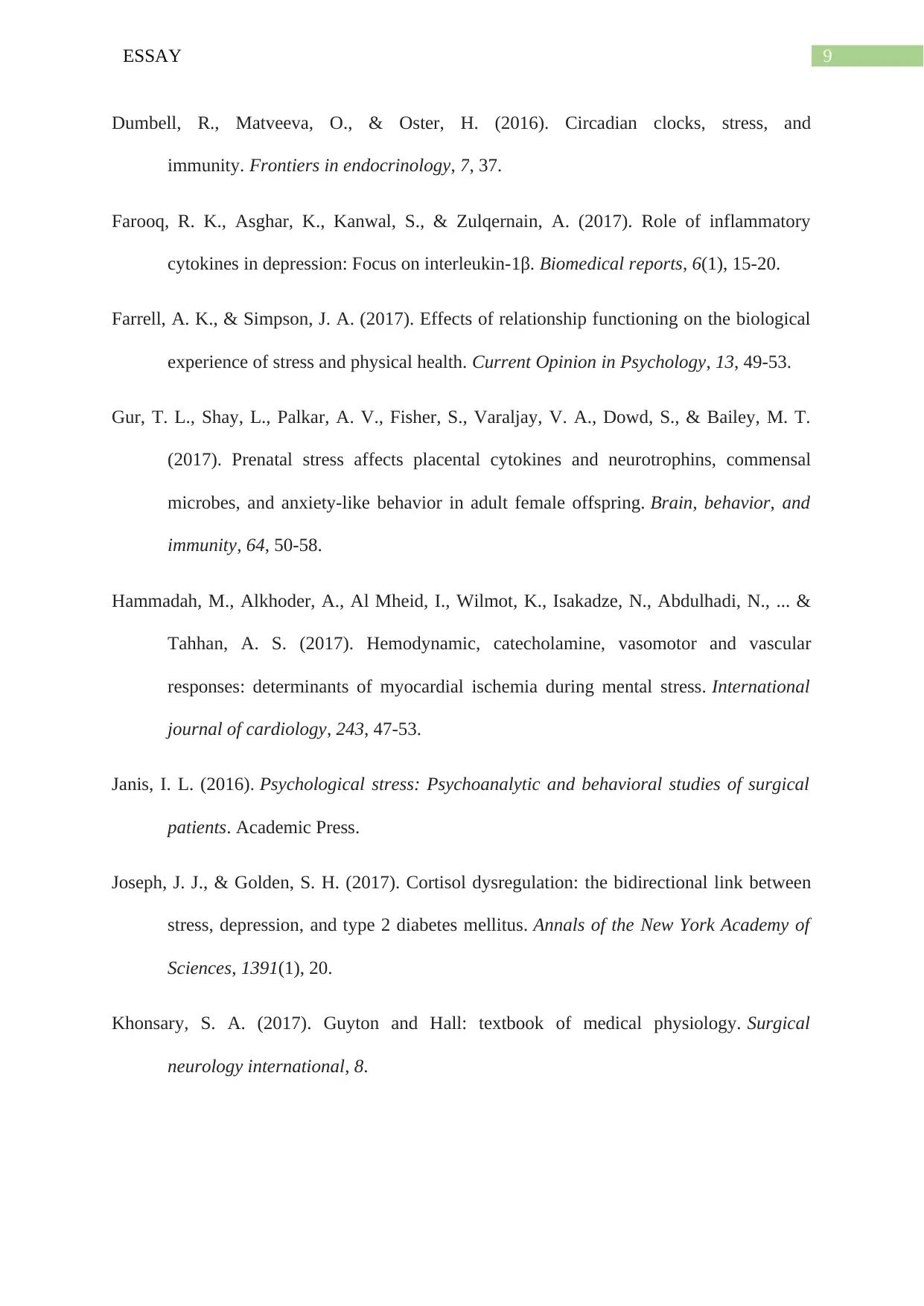
9ESSAY
Dumbell, R., Matveeva, O., & Oster, H. (2016). Circadian clocks, stress, and
immunity. Frontiers in endocrinology, 7, 37.
Farooq, R. K., Asghar, K., Kanwal, S., & Zulqernain, A. (2017). Role of inflammatory
cytokines in depression: Focus on interleukin-1β. Biomedical reports, 6(1), 15-20.
Farrell, A. K., & Simpson, J. A. (2017). Effects of relationship functioning on the biological
experience of stress and physical health. Current Opinion in Psychology, 13, 49-53.
Gur, T. L., Shay, L., Palkar, A. V., Fisher, S., Varaljay, V. A., Dowd, S., & Bailey, M. T.
(2017). Prenatal stress affects placental cytokines and neurotrophins, commensal
microbes, and anxiety-like behavior in adult female offspring. Brain, behavior, and
immunity, 64, 50-58.
Hammadah, M., Alkhoder, A., Al Mheid, I., Wilmot, K., Isakadze, N., Abdulhadi, N., ... &
Tahhan, A. S. (2017). Hemodynamic, catecholamine, vasomotor and vascular
responses: determinants of myocardial ischemia during mental stress. International
journal of cardiology, 243, 47-53.
Janis, I. L. (2016). Psychological stress: Psychoanalytic and behavioral studies of surgical
patients. Academic Press.
Joseph, J. J., & Golden, S. H. (2017). Cortisol dysregulation: the bidirectional link between
stress, depression, and type 2 diabetes mellitus. Annals of the New York Academy of
Sciences, 1391(1), 20.
Khonsary, S. A. (2017). Guyton and Hall: textbook of medical physiology. Surgical
neurology international, 8.
Dumbell, R., Matveeva, O., & Oster, H. (2016). Circadian clocks, stress, and
immunity. Frontiers in endocrinology, 7, 37.
Farooq, R. K., Asghar, K., Kanwal, S., & Zulqernain, A. (2017). Role of inflammatory
cytokines in depression: Focus on interleukin-1β. Biomedical reports, 6(1), 15-20.
Farrell, A. K., & Simpson, J. A. (2017). Effects of relationship functioning on the biological
experience of stress and physical health. Current Opinion in Psychology, 13, 49-53.
Gur, T. L., Shay, L., Palkar, A. V., Fisher, S., Varaljay, V. A., Dowd, S., & Bailey, M. T.
(2017). Prenatal stress affects placental cytokines and neurotrophins, commensal
microbes, and anxiety-like behavior in adult female offspring. Brain, behavior, and
immunity, 64, 50-58.
Hammadah, M., Alkhoder, A., Al Mheid, I., Wilmot, K., Isakadze, N., Abdulhadi, N., ... &
Tahhan, A. S. (2017). Hemodynamic, catecholamine, vasomotor and vascular
responses: determinants of myocardial ischemia during mental stress. International
journal of cardiology, 243, 47-53.
Janis, I. L. (2016). Psychological stress: Psychoanalytic and behavioral studies of surgical
patients. Academic Press.
Joseph, J. J., & Golden, S. H. (2017). Cortisol dysregulation: the bidirectional link between
stress, depression, and type 2 diabetes mellitus. Annals of the New York Academy of
Sciences, 1391(1), 20.
Khonsary, S. A. (2017). Guyton and Hall: textbook of medical physiology. Surgical
neurology international, 8.
Paraphrase This Document
Need a fresh take? Get an instant paraphrase of this document with our AI Paraphraser
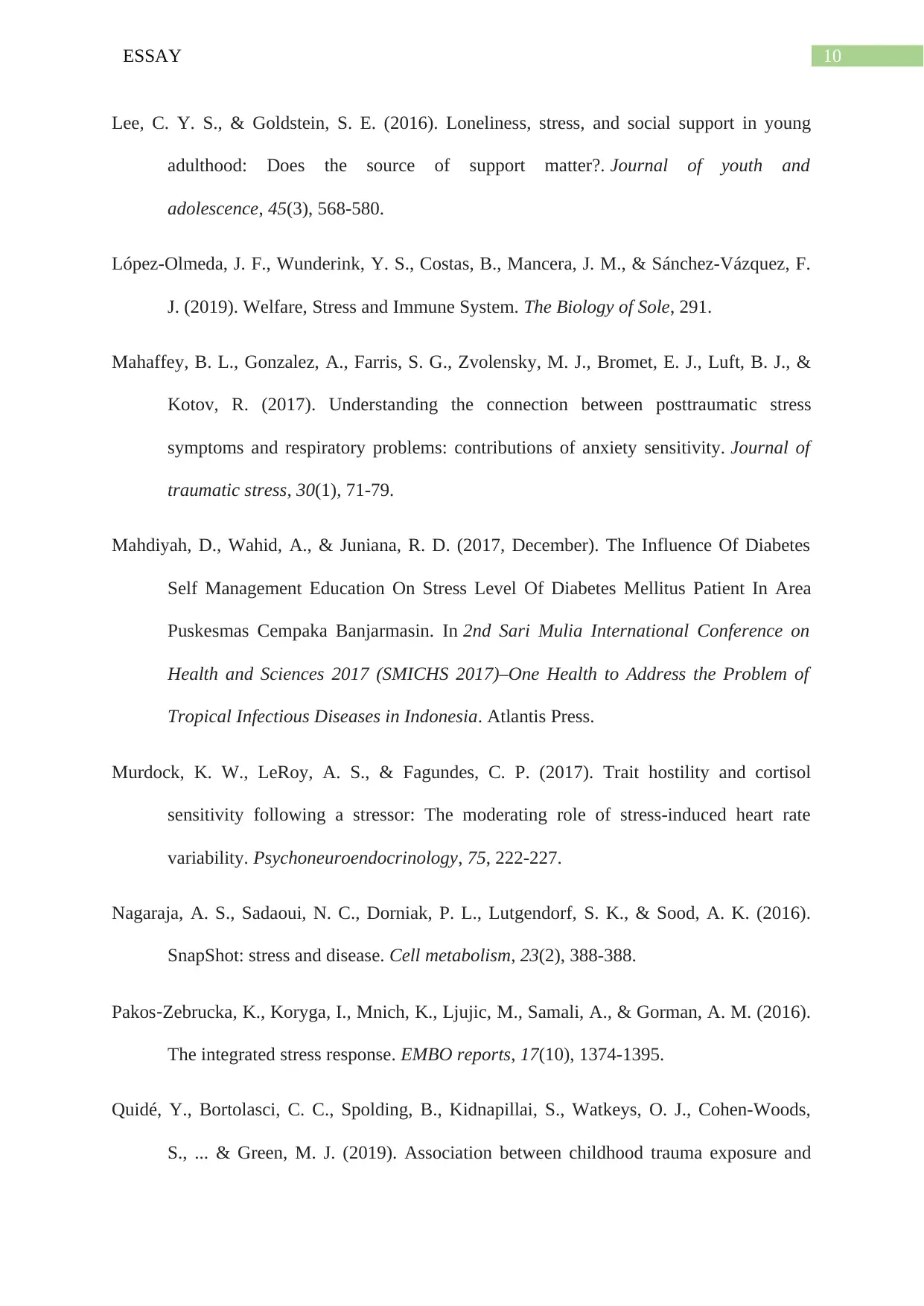
10ESSAY
Lee, C. Y. S., & Goldstein, S. E. (2016). Loneliness, stress, and social support in young
adulthood: Does the source of support matter?. Journal of youth and
adolescence, 45(3), 568-580.
López-Olmeda, J. F., Wunderink, Y. S., Costas, B., Mancera, J. M., & Sánchez-Vázquez, F.
J. (2019). Welfare, Stress and Immune System. The Biology of Sole, 291.
Mahaffey, B. L., Gonzalez, A., Farris, S. G., Zvolensky, M. J., Bromet, E. J., Luft, B. J., &
Kotov, R. (2017). Understanding the connection between posttraumatic stress
symptoms and respiratory problems: contributions of anxiety sensitivity. Journal of
traumatic stress, 30(1), 71-79.
Mahdiyah, D., Wahid, A., & Juniana, R. D. (2017, December). The Influence Of Diabetes
Self Management Education On Stress Level Of Diabetes Mellitus Patient In Area
Puskesmas Cempaka Banjarmasin. In 2nd Sari Mulia International Conference on
Health and Sciences 2017 (SMICHS 2017)–One Health to Address the Problem of
Tropical Infectious Diseases in Indonesia. Atlantis Press.
Murdock, K. W., LeRoy, A. S., & Fagundes, C. P. (2017). Trait hostility and cortisol
sensitivity following a stressor: The moderating role of stress-induced heart rate
variability. Psychoneuroendocrinology, 75, 222-227.
Nagaraja, A. S., Sadaoui, N. C., Dorniak, P. L., Lutgendorf, S. K., & Sood, A. K. (2016).
SnapShot: stress and disease. Cell metabolism, 23(2), 388-388.
Pakos‐Zebrucka, K., Koryga, I., Mnich, K., Ljujic, M., Samali, A., & Gorman, A. M. (2016).
The integrated stress response. EMBO reports, 17(10), 1374-1395.
Quidé, Y., Bortolasci, C. C., Spolding, B., Kidnapillai, S., Watkeys, O. J., Cohen-Woods,
S., ... & Green, M. J. (2019). Association between childhood trauma exposure and
Lee, C. Y. S., & Goldstein, S. E. (2016). Loneliness, stress, and social support in young
adulthood: Does the source of support matter?. Journal of youth and
adolescence, 45(3), 568-580.
López-Olmeda, J. F., Wunderink, Y. S., Costas, B., Mancera, J. M., & Sánchez-Vázquez, F.
J. (2019). Welfare, Stress and Immune System. The Biology of Sole, 291.
Mahaffey, B. L., Gonzalez, A., Farris, S. G., Zvolensky, M. J., Bromet, E. J., Luft, B. J., &
Kotov, R. (2017). Understanding the connection between posttraumatic stress
symptoms and respiratory problems: contributions of anxiety sensitivity. Journal of
traumatic stress, 30(1), 71-79.
Mahdiyah, D., Wahid, A., & Juniana, R. D. (2017, December). The Influence Of Diabetes
Self Management Education On Stress Level Of Diabetes Mellitus Patient In Area
Puskesmas Cempaka Banjarmasin. In 2nd Sari Mulia International Conference on
Health and Sciences 2017 (SMICHS 2017)–One Health to Address the Problem of
Tropical Infectious Diseases in Indonesia. Atlantis Press.
Murdock, K. W., LeRoy, A. S., & Fagundes, C. P. (2017). Trait hostility and cortisol
sensitivity following a stressor: The moderating role of stress-induced heart rate
variability. Psychoneuroendocrinology, 75, 222-227.
Nagaraja, A. S., Sadaoui, N. C., Dorniak, P. L., Lutgendorf, S. K., & Sood, A. K. (2016).
SnapShot: stress and disease. Cell metabolism, 23(2), 388-388.
Pakos‐Zebrucka, K., Koryga, I., Mnich, K., Ljujic, M., Samali, A., & Gorman, A. M. (2016).
The integrated stress response. EMBO reports, 17(10), 1374-1395.
Quidé, Y., Bortolasci, C. C., Spolding, B., Kidnapillai, S., Watkeys, O. J., Cohen-Woods,
S., ... & Green, M. J. (2019). Association between childhood trauma exposure and
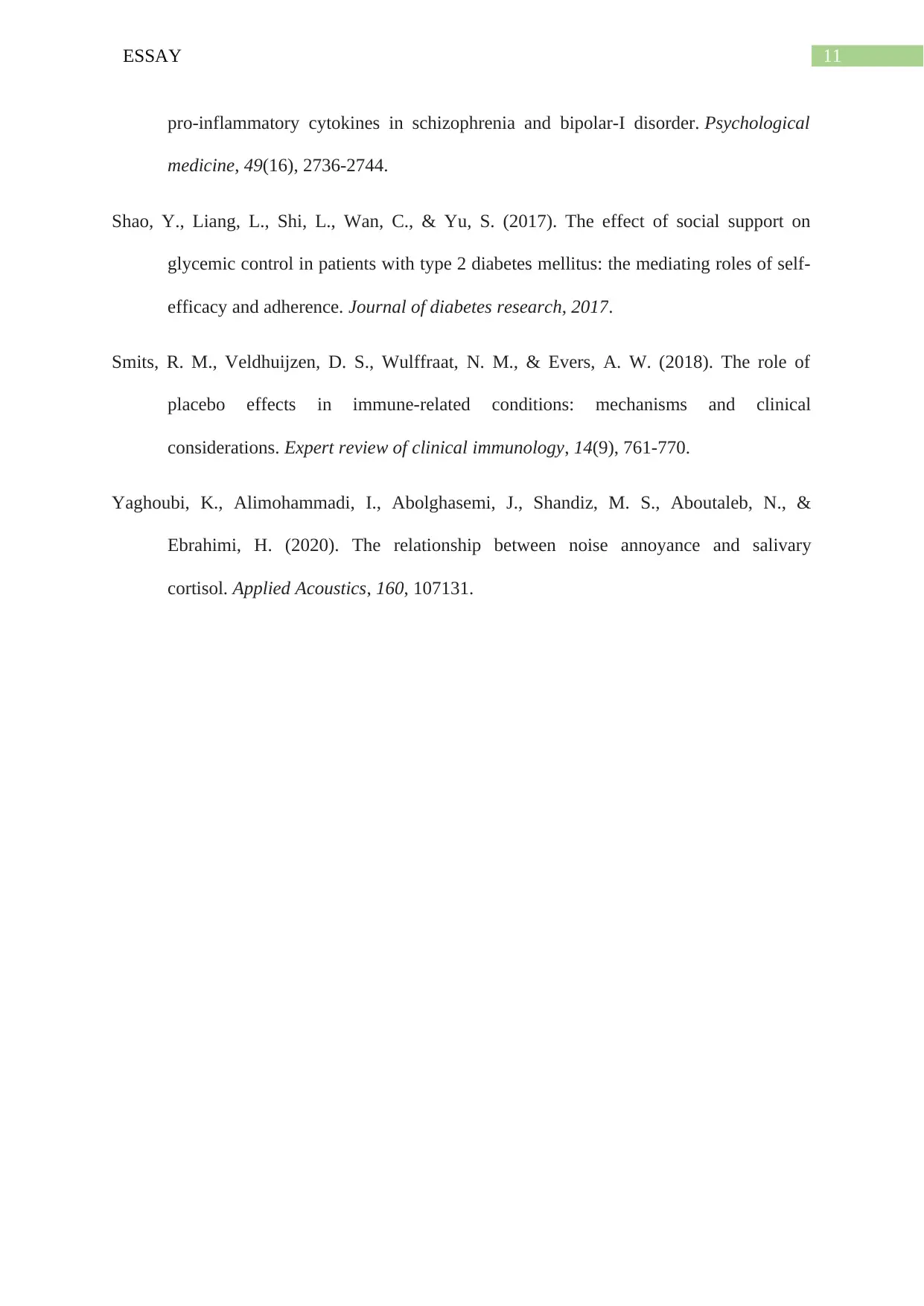
11ESSAY
pro-inflammatory cytokines in schizophrenia and bipolar-I disorder. Psychological
medicine, 49(16), 2736-2744.
Shao, Y., Liang, L., Shi, L., Wan, C., & Yu, S. (2017). The effect of social support on
glycemic control in patients with type 2 diabetes mellitus: the mediating roles of self-
efficacy and adherence. Journal of diabetes research, 2017.
Smits, R. M., Veldhuijzen, D. S., Wulffraat, N. M., & Evers, A. W. (2018). The role of
placebo effects in immune-related conditions: mechanisms and clinical
considerations. Expert review of clinical immunology, 14(9), 761-770.
Yaghoubi, K., Alimohammadi, I., Abolghasemi, J., Shandiz, M. S., Aboutaleb, N., &
Ebrahimi, H. (2020). The relationship between noise annoyance and salivary
cortisol. Applied Acoustics, 160, 107131.
pro-inflammatory cytokines in schizophrenia and bipolar-I disorder. Psychological
medicine, 49(16), 2736-2744.
Shao, Y., Liang, L., Shi, L., Wan, C., & Yu, S. (2017). The effect of social support on
glycemic control in patients with type 2 diabetes mellitus: the mediating roles of self-
efficacy and adherence. Journal of diabetes research, 2017.
Smits, R. M., Veldhuijzen, D. S., Wulffraat, N. M., & Evers, A. W. (2018). The role of
placebo effects in immune-related conditions: mechanisms and clinical
considerations. Expert review of clinical immunology, 14(9), 761-770.
Yaghoubi, K., Alimohammadi, I., Abolghasemi, J., Shandiz, M. S., Aboutaleb, N., &
Ebrahimi, H. (2020). The relationship between noise annoyance and salivary
cortisol. Applied Acoustics, 160, 107131.
⊘ This is a preview!⊘
Do you want full access?
Subscribe today to unlock all pages.

Trusted by 1+ million students worldwide
1 out of 12
Related Documents
Your All-in-One AI-Powered Toolkit for Academic Success.
+13062052269
info@desklib.com
Available 24*7 on WhatsApp / Email
![[object Object]](/_next/static/media/star-bottom.7253800d.svg)
Unlock your academic potential
Copyright © 2020–2025 A2Z Services. All Rights Reserved. Developed and managed by ZUCOL.




